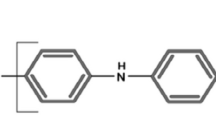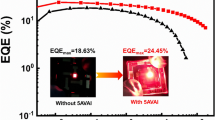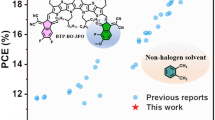Abstract
Black polyimides (BPIs) have attracted increasing attention owing to their growing demand in optoelectronics. However, commonly used black polyimides doped with black fillers suffer from poor mechanical and electrical properties. To address these issues, a new diamine (2,5-bis(4′-amino-[1,1′-biphenyl]-4-yl)-3,4-bis(4-fluorophenyl)cyclopenta-2,4-dien-1-one, TPCPFPDA) bearing a tetraphenylcyclopentadienone (TPCP) moiety bonded with benzene and fluorine units was synthesized. The diamine was reacted with 4,4′-(hexafluoroisopropylidene) diphthalic anhydride (6FDA) to yield a soluble intrinsic black polyimide (TPCPFPPI). Bonding fluorine (auxochrome group) and benzene units to TPCP can increase the conjugation of π-electrons systems and facilitate the movement of electron throughout the big π bond, respectively. Owing to the structural features, the synthesized TPCPFPPI exhibited complete visible-light absorption with high blackness and opacity. Its cutoff wavelength (λcut) and CIE (Commission Internationale de I’ Eclairage) parameter L* were 684 nm and 1.33, respectively. Moreover, TPCPFPPI displayed exceptional electrical, mechanical, and thermal properties as well as excellent solubility. A detailed theoretical calculation was conducted to gain better insight into the electronic properties of the TPCPFPPI. Results showed that the blackness of TPCPFPPI was chiefly attributed to the electron transition from highest occupied molecular orbital (HOMO) to lowest unoccupied molecular orbital (LUMO) in the diamines, where the charges primarily migrated from the aryl groups in the 2- and 5-positions to the cyclopentadienone center. The as-obtained intrinsic BPI (TPCPFPPI), exhibiting both high solubility and outstanding overall properties, has important applications in photo-electronics.
Similar content being viewed by others
References
Gouzman I, Grossman E, Verker R, et al. Advances in polyimide-based materials for space applications. Adv Mater, 2019, 31: 1807738
Yi C, Li W, Shi S, et al. High-temperature-resistant and colorless polyimide: Preparations, properties, and applications. Sol Energy, 2020, 195: 340–354
Liaw D J, Wang K L, Huang Y C, et al. Advanced polyimide materials: Syntheses, physical properties and applications. Prog Polym Sci, 2012, 37: 907–974
Jiang S, Cheong J Y, Nam J S, et al. High-density fibrous polyimide sponges with superior mechanical and thermal properties. ACS Appl Mater Interfaces, 2020, 12: 19006–19014
Yu S, Liu Y, Ding C, et al. All-organic sandwich structured polymer dielectrics with polyimide and PVDF for high temperature capacitor application. J Energy Storage, 2023, 62: 106868
Romyen N, Thongyai S, Praserthdam P. Surfactant-dispersed carbon black in polyimide nanocomposites: Spectroscopic monitoring of the dispersion state in the polymer matrix. J Appl Polym Sci, 2010, 115: 1622–1629
Kim J, Kim G, Kim S Y, et al. Fabrication of highly flexible electromagnetic interference shielding polyimide carbon black composite using hot-pressing method. Compos Part B-Eng, 2021, 221: 109010
Atar N, Grossman E, Gouzman I, et al. Atomic-oxygen-durable and electrically-conductive cnt-poss-polyimide flexible films for space applications. ACS Appl Mater Interfaces, 2015, 7: 12047–12056
Jiang Q, Wang X, Zhu Y, et al. Mechanical, electrical and thermal properties of aligned carbon nanotube/polyimide composites. Compos Part B-Eng, 2014, 56: 408–412
Yoonessi M, Shi Y, Scheiman D A, et al. Graphene polyimide nanocomposites; thermal, mechanical, and high-temperature shape memory effects. ACS Nano, 2012, 6: 7644–7655
Yoonessi M, Gaier J R, Sahimi M, et al. Fabrication of graphene-polyimide nanocomposites with superior electrical conductivity. ACS Appl Mater Interfaces, 2017, 9: 43230–43238
Wang H, Zhu D, Zhou W, et al. Influence of heat treatment on electromagnetic properties of polyimide/carbon black composites. Polym Adv Technol, 2015, 25: 1616–1621
Wu G, Tang Y, Weng R. Dispersion of nano-carbon filled polyimide composites using self-degradated low molecular poly(amic acid) as impurity-free dispersant. Polym Degrad Stab, 2010, 95: 1449–1455
Qian M, Liu G, Zhou B, et al. Atomic oxygen durable ultra-black polyimide nanocomposite films in solar spectrum. Polym Degrad Stab, 2020, 175: 109133
Kong D, Li J, Guo A, et al. High temperature electromagnetic shielding shape memory polymer composite. Chem Eng J, 2021, 408: 127365
Zhang Q, Xu Y, Yang Y, et al. Conductive mechanism of carbon black/polyimide composite films. J Polym Eng, 2018, 38: 147–156
Shao D, Xu C, Du J, et al. Trichromatic dyeing of polyimide fiber using its inherent color as a yellow component. Fibers Polym, 2020, 21: 1783–1789
Hasegawa M, Horie K. Photophysics, photochemistry, and optical properties of polyimides. Prog Polym Sci, 2001, 26: 259–335
Ando S, Matsuura T, Sasaki S. Coloration ofaromatic polyimides and electronic properties of their source materials. Polym J, 1997, 29: 69–76
Choi M C, Wakita J, Ha C S, et al. Highly transparent and refractive polyimides with controlled molecular structure by chlorine side groups. Macromolecules, 2009, 42: 5112–5120
Spechler J A, Koh T W, Herb J T, et al. A transparent, smooth, thermally robust, conductive polyimide for flexible electronics. Adv Funct Mater, 2015, 25: 7428–7434
Zhai L, Yang S, Fan L. Preparation and characterization of highly transparent and colorless semi-aromatic polyimide films derived from alicyclic dianhydride and aromatic diamines. Polymer, 2012, 53: 3529–3539
Zhang Y, Tan Y, Liu J, et al. Molecular design, synthesis and characterization of intrinsically black polyimide films with high thermal stability and good electrical properties. J Polym Res, 2019, 26: 171
Zhou Y, Zhang S, Zheng F, et al. Intrinsically black polyimide with retained insulation and thermal properties: A black anthraquinone derivative capable oflinear copolymerization. Macromolecules, 2021, 54: 9307–9318
Hu Y C, Chen C J, Yen H J, et al. Novel triphenylamine-containing ambipolar polyimides with pendant anthraquinone moiety for polymeric memory device, electrochromic and gas separation applications. J Mater Chem, 2012, 22: 20394–20402
Coluccini C, Anusha P T, Chen H Y T, et al. Tuning of the electro-optical properties of tetraphenylcyclopentadienone via substitution of oxygen with sterically-hindered electron withdrawing groups. Sci Rep, 2019, 9: 12762
Bar N, Chowdhury P. A brief review on advances in rhodamine b based chromic materials and their prospects. ACS Appl Electron Mater, 2022, 4: 3749–3771
Liu Y, Huang J, Tan J H, et al. Intrinsic high-barrier polyimide with low free volume derived from a novel diamine monomer containing rigid planar moiety. Polymer, 2017, 114: 289–297
Ren X, Zhang Y, Liu Y, et al. Preparation and properties of intrinsically black polyimide films with cie lab color parameters close to zero and high thermal stability for potential applications in flexible printed circuit boards. Polymers, 2022, 14: 3881
Wyszecki G, Stiles W S. Color Science: Concepts and Methods, Quantitative Data and Formulae. 2nd ed. New York: John Wiley & Sons, 2000
Yi C, Sun Y, Pi H, et al. Low-temperature UV irradiation induced the color change kinetics and the corresponding structure development of PVC film. J Appl Polym Sci, 2011, 122: 2588–2593
Li W, Ning J, Yin Y, et al. Thieno[3,2-b]thiophene-based conjugated copolymers for solution-processable neutral black electrochromism. Polym Chem, 2018, 9: 5608–5616
Lo C K, Shen D E, Reynolds J R. Fine-tuning the color hue of π-conjugated black-to-clear electrochromic random copolymers. Macromolecules, 2019, 52: 6773–6779
Tan Y, An Y, Jia Y, et al. Preparation and properties of intrinsically deep-color thermoplastic polyimide films with low curing temperatures (in Chinese). Insulat Mater, 2021, 54: 75–83
Tan Y, Zhang Y, Jiang G, et al. Preparation and properties of inherently black polyimide films with extremely low coefficients of thermal expansion and potential applications for black flexible copper clad laminates. Polymers, 2020, 12: 576
Wellinghoff S T, Ishida H, Koenig J L, et al. Spectroscopic studies of poly[N, N′-bis(phenoxyphenyl)pyromellitimide]. 2. Structural changes of polyimide upon yielding. Macromolecules, 1980, 13: 834–839
Xing A, Miao X, Liu T, et al. An intrinsic white-light-emitting hyperbranched polyimide: Synthesis, structure-property and its application as a “turn-off” sensor for iron(III) ions. J Mater Chem C, 2019, 7: 14320–14333
Frisch M, Trucks G, Schlegel H, et al. Gaussian 09. Revision D. 01. Wallingford, CT: Gaussian. Inc., 2009
Zhou Z, Zhang Y, Liu S, et al. Flexible and highly fluorescent aromatic polyimide: Design, synthesis, properties, and mechanism. J Mater Chem C, 2016, 4: 10509–10517
Lu T, Chen F. Multiwfn: A multifunctional wavefunction analyzer. J Comput Chem, 2012, 33: 580–592
Le Y, An W, Chen J F. The preparation and TD-DFT studies of 1-[(4-methyl-2-nitrophenyl) azo]-2-naphthalenol (C.I. Pigment Red 3) nanoparticles. Dyes Pigm, 2010, 87: 119–124
Liu Y, Qian C, Qu L, et al. A bulk dielectric polymer film with intrinsic ultralow dielectric constant and outstanding comprehensive properties. Chem Mater, 2015, 27: 6543–6549
Dhara M G, Banerjee S. Fluorinated high-performance polymers: Poly (arylene ether)s and aromatic polyimides containing trifluoromethyl groups. Prog Polym Sci, 2010, 35: 1022–1077
Xie K, Zhang S Y, Liu J G, et al. Synthesis and characterization of soluble fluorine-containing polyimides based on 1,4-bis(4-amino-2-trifluoromethylphenoxy)benzene. J Polym Sci Polym Chem, 2001, 39: 2581–2590
Ni H, Liu J, Wang Z, et al. A review on colorless and optically transparent polyimide films: Chemistry, process and engineering applications. J Ind Eng Chem, 2015, 28: 16–27
Li C, Yi L, Xu S, et al. Synthesis and characterization of polyimides from 4,4’-(3-(tert-butyl)-4-aminophenoxy) diphenyl ether. J Polym Res, 2017, 24: 1–9
Liu Y, Xie F, Huang J, et al. The effect of molecular isomerism on the barrier properties of polyimides: Perspectives from experiments and simulations. Polymers, 2021, 13: 1749
Diaham S, Zelmat S, Locatelli M L, et al. Dielectric breakdown of polyimide films: Area, thickness and temperature dependence. IEEE Trans Dielect Electr Insul, 2010, 17: 18–27
Luo H, Yan C, Liu X, et al. Constructing novel high-performance dipolar glass polymer dielectrics by polar rigid/flexible side chains. ACS Appl Mater Interfaces, 2023, 15: 24470–24482
Liu X J, Zheng M S, Chen G, et al. High-temperature polyimide dielectric materials for energy storage: Theory, design, preparation and properties. Energy Environ Sci, 2022, 15: 56–81
Tao L, Yang H, Liu J, et al. Synthesis and characterization of highly optical transparent and low dielectric constant fluorinated polyimides. Polymer, 2009, 50: 6009–6018
Yu S, Ding C, Liu Y, et al. Enhanced breakdown strength and energy density over a broad temperature range in polyimide dielectrics using oxidized MXenes filler. J Power Sources, 2022, 535: 231415
Liu H, Liu J, Liu T, et al. Effects of dispersant on properties of carbon black/polyimide composite films (in Chinese). Insulat Mater, 2021, 54: 84–87
Fu Z, Cao X, Liu M, et al. Development of ultra-thin black coverlay for wireless charging (in Chinese). Printed Circuit Information, 2019, 4: 18–21
Niu Y, Zhang X, Fang Q, et al. Fabrication, optical and electrical properties of solvethermal reduced graphene oxide/polyimide composites by in situ polymerization. Synth Met, 2017, 224: 86–91
Feng Y, Luo L B, Huang J, et al. Effect of molecular rigidity and hydrogen bond interaction on mechanical properties of polyimide fibers. J Appl Polym Sci, 2016, 133: 43677
Liu T Q, Zheng F, Ding T M, et al. Design and synthesis of a novel quinoxaline diamine and its polyimides with high-Tg and red color. Polymer, 2019, 179: 121612
Kwon J, Kim J, Lee J, et al. Fabrication of polyimide composite films based on carbon black for high-temperature resistance. Polym Compos, 2014, 35: 2214–2220
Liu Y, Zhang Y, Lan Q, et al. High-performance functional polyimides containing rigid nonplanar conjugated triphenylethylene moieties. Chem Mater, 2012, 24: 1212–1222
Author information
Authors and Affiliations
Corresponding authors
Additional information
This work was supported by the National Natural Science Foundation of China (GrantNos. 51973055 & 52103004), the Natural Science Foundation of Hunan Province (Grant No. 2021JJ50004), the Science Research Project of Hunan Provincial Department of Education (Grant No. 21A0364), and the Student Innovation and Entrepreneurship Training Program of Hunan Province (Grant No. S202211535096).
Supporting Information
The supporting information is available online at tech.scichina.com and link.springer.com. The supporting materials are published as submitted, without typesetting or editing. The responsibility for scientific accuracy and content remains entirely with the authors.
Rights and permissions
About this article
Cite this article
Tan, J., Shen, J., Huang, J. et al. Synthesis and characterization of soluble intrinsic black polyimide with excellent comprehensive properties. Sci. China Technol. Sci. 66, 3604–3614 (2023). https://doi.org/10.1007/s11431-023-2476-6
Received:
Accepted:
Published:
Issue Date:
DOI: https://doi.org/10.1007/s11431-023-2476-6




